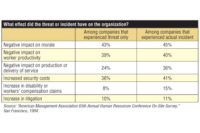Healthcare institutions have managed workplace violence with measurable success, despite the challenges faced in hospitals, emergency rooms, mental health, nursing homes, long-term care and community healthcare facilities. The magnitude of the problem is astounding – its devastating impact looms mightily in the hearts and minds of boards of directors, C-suites and security directors as both a real institutional threat and a contentious business reality facing healthcare today.
As an institution, healthcare has adapted well to managing the complexities and propensities for violence in medical settings, but it is a particularly complex and dangerous occupation for healthcare employees, patients and bystanders.
That danger arises from exposure to violent individuals combined with the absence of strong violence prevention programs and protective regulations. Other contributing factors such as staff shortages and increased patient acuity add to the problem.
The healthcare culture’s resistance to the idea that providers are at risk is a key consideration that affects the value of aggressive prevention strategies based on responsibility, accountability and consequences.
Integration and collaboration of resources in combating workplace violence is a work in progress that benefits an engaged system. Accepting that violence in healthcare settings is truly high-risk requires a multi-dimensional and multi-disciplinary approach that holds itself accountable. To change the culture:
• Prepare for the “WHEN,” not the “IF”
• Recognize the realities and take appropriate measures
• Maximize the value of shared resources
• Enforce and support existing plans
• Adopt innovative proactive strategies
• Conduct internal and external ongoing self-assessments and validations
Waiting for the “if” can have a long-term, disastrous impact on morale, service and reputation. We see negligence in training, security and supervision in our daily operations — most vividly following catastrophic incidents that show how ill-prepared was the organization.
Training that focuses solely on compliance is a disaster waiting to happen. Generally, organizations have resorted to cost-effective approaches for training on workplace violence that include online courses without the benefit of a facilitator to ask “what if” questions.
One must recognize that the healthcare system is a business that attaches budgetary constraints to decisions that adversely affect security and training, a mindset that should be revised as soon as possible.
The U.S. healthcare system is in the beginning of a crisis. If projections are accurate, the demand for nurses will increase 40 percent, and a 400,000-hour full-time equivalent registered nurse shortfall will occur by 2020. Such realities underscore the value of integrating and collaborating resources.
Changing the culture also necessitates a balanced reliance on the doctor’s influence over safety and security by adding more voices to the discussion. Relegating the security mission solely to the security director and staff defeats the benefits of a collective effort, shared resources and a supportive senior management. Senior management involvement, essential to combating workplace violence, pertains to accountability, responsibility and consequences.
In the last 15 years, deaths resulting from workplace violence have ranked among the top four causes of occupational fatalities in American workplaces. In response, OSHA released a new compliance directive last September that offers procedures for staff who respond to workplace violence cases.
The directive, Enforcement Procedures for Investigating or Inspecting Incidents of Workplace Violence, establishes procedures for conducting inspections in late-night retail workplaces and health care and social service settings, which may be at a higher risk of workplace violence.
“Research has identified factors that may increase the risk of violence at worksites,” the directive states. “Such factors include working with the public or volatile, unstable people. Working alone or in isolated areas may also contribute to the potential for violence. ... Additionally, time of day and location of work, such as working late at night or in areas with high crime rates, are also risk factors that should be considered when addressing issues of workplace violence.”
A recent OSHA inspection of a Maine psychiatric hospital found more than 90 instances in which workers were assaulted by patients from 2008 through 2010. OSHA cited the hospital for not providing adequate safeguards against workplace violence and proposed a fine of more than $6,000.
“These incidents, and others like them, can be avoided or decreased if employers take appropriate precautions to protect their workers,” said OSHA Administrator David Michaels, Ph.D.
More than 3,000 people died from workplace homicide between 2006 and 2010, according to the Bureau of Labor Statistics (BLS). Additional BLS data indicates that an average of more than 15,000 nonfatal workplace injury cases was reported annually during this time.
Similar studies by the National Institute for Occupational Safety and Health and other organizations show that employers who implement effective safety measures can reduce the incidence of workplace violence, including:
• training employees on workplace violence
• encouraging employees to report assaults or threats
• conducting hazard analyses
• access controls
• safe rooms for use during emergencies
More than 70 percent of U.S. workplaces do not have a formal program addressing workplace violence. Studies suggest that the number of healthcare employees at risk might be even higher than the data reports simply because employees would rather protect their jobs than report incidents.
Consider dealing with the realities of worker safety by imposing patient standards of security. Without management’s creative innovation, employees might begin to confront risks with a dismissive attitude, not acknowledging the need to take appropriate measures.
In some cases, employees and management begin to accept the notion that hazards come with the job, take it or leave it. This unfortunate attitude contributes to individual and organizational risk by:
• perception of negligence or poor job performance
• employee loss of trust and confidence in the system
• stigma of victimization
• a reporting system with excessive paperwork
• no follow up or documentation
• a lack of support from management
While the debate of balance between security and management continues, the contentious realities of the need to invest in state-of-the-art physical security, access control and visitor management systems have yielded results formed from the basis for long-term security and technology ROI strategies. On the human resource side, efforts have been made to quantify and measure incidents through data collection systems and adding baselines in security programming and training.
The Joint Commission’s Sentinel Event Alerts and Data Base Reports now provide more than sufficient corroborative information and data-mining capability in justifying and applying relevant, appropriate methodologies. Armed with this consolidated data, security directors can map out courses of action consistent with policies, regulations and budgets that offer global intervention strategies and perspectives in enhancing security — showing management’s commitment. Avoid overreacting to situations but rather to have a measured response when confronting the issues of healthcare safety and security. Compliance is not prevention.
What else can be done? Consider methodologies suggested here:
• Collaborate with employee organizations and family advocates
• Dispel the myths that workplace violence is not preventable
• Integrate multiple intervention strategies
• Implement and review violence prevention and emergency response strategies frequently
• Coordinate employee training
• Coordinate and understand the legal implications of what you can and cannot do
• Synergize the organization’s capabilities to manage an agile and robust violence prevention and response plan
• Review reporting procedures
• Assess and evaluate system root causes and contributing factors
• Influence a top-down accountable management commitment
• Define a sharing role between HR and security
Senior managers must define the leader’s role in helping identify specific expectations, which might appear on annual performance reviews and ratings.
Supervisors should be held accountable for managing potential conflicts, de-escalating disputes, resolving issues and recommending changes to minimize future risks. Employee complaints and reports filed with supervision can increase credibility in reporting when expeditiously resolved, and current approaches to handling patient-employee violence must be reviewed and presented to senior management.
Create a culture of connectivity up and down the organization by integrating resources in sharing security responsibilities. Break the traditional views that withhold creative approaches to innovative thinking about alternative workplace violence prevention strategies and approaches. For example:
• Minimize employee and patient risk through frequent assessments and evaluations
• Use safe rooms and sheltering
• Do not avoid of training out of fear of disclosing concepts or impeding nursing or doctor schedules
• Include police and emergency responders in your training plans
• Promote organization-wide awareness and responsibility
In the end, your commitment is judged by your measured response. One employee once told me that his organization’s workplace violence prevention efforts are a joke. When I asked why, he responded by saying, “Because nobody ever asked me for my opinion.”



